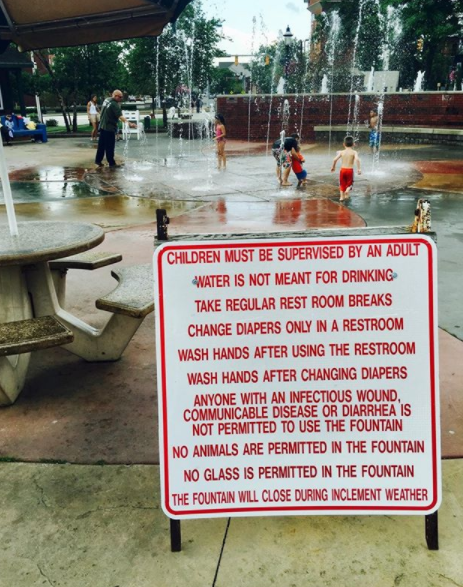
Signs are all around, and many of them are put in our public realm by us, government. They are in our public spaces, parks, squares, and walkways – all places that are typically designed for people to come together to do the things they enjoy. However, government signs generally lists prohibited activities. No feeding the geese. No glass in the fountain. No this. No that. No. No. No! While these rules serve a purpose, they may also have unintended consequences.
A NYC Example
 I recently heard Mitchell Silver speak, Park and Recreation Commissioner for the City of New York who is working to make NYC parks equitable, places for all people, of all incomes, and all ages, who live in all corners of the City. In NYC, there is a law that adults cannot be in a playground except in the company of child. No doubt as the result of a tragedy of child safety, but these signs also had the effect of preventing our adults, including the elderly, who wanted to sit, stay, find enjoyment in spaces where people of all ages, including kids were playing. So what did he do? He moved the signs.
I recently heard Mitchell Silver speak, Park and Recreation Commissioner for the City of New York who is working to make NYC parks equitable, places for all people, of all incomes, and all ages, who live in all corners of the City. In NYC, there is a law that adults cannot be in a playground except in the company of child. No doubt as the result of a tragedy of child safety, but these signs also had the effect of preventing our adults, including the elderly, who wanted to sit, stay, find enjoyment in spaces where people of all ages, including kids were playing. So what did he do? He moved the signs.
Bottom line, negative messages full of distrust can have a disheartening effect on people in the places that are meant to be for everyone, places where people should feel welcome and happy, and spaces that could be sources of community pride. But it doesn’t have to be that way. So, this ELGL member the Urban Design Team in the City of Charlotte, and Mecklenburg County with funding from the Knight Foundation partnered to try something new, to harness the power of words and signage to promote joy, instead of rules! Our project is called Can Do Signs.
The Research
First, we wanted to understand the data, so we partnered with the Center for Active Design to conduct a nation survey aimed at evaluating positive signage’s effect on civic engagement outcomes. What was found, was revealing. Positive Signs, (Can Do Signs), when compared to typical rules-based signage, result in increased level of pride in community by 11% and an increase in the perception that City cares about its public space users 9% relative to typical rules based signs. Big impact for a little sign, proving that messages matter, and can help bridge the gap between government and residents.
More About the Project
The goal of Can Do signage is to flip the typical usage of signs. Instead, of listing rules, the project team asked the community what they want to do, and then created signs to give users of public space amusing, enchanting and fun options. The signs also share messages of trust and invite people to interact. You can dance! You can high five a friend! You can meet someone new! You can downward dog with your dog!

Inspired by feedback and ideas from employees, residents, and school kids received, online, in person, and through in an idea generating contest, over the course of a year, signs were installed. They were placed in parks, greenways, trails, t nature preserves, and iconic neighborhood corners. A Can Do Sign was even installed at the the Charlotte Airport! We did Can Do Signs in other languages to promote inclusivity and send the message that everyone is welcome to enjoy public space

People Have Fun!
What we found is that people are finding joy in what at first glance looks like a government sign, but with an unexpected and whimsical twist. Residents are sharing their pictures with the hashtag #CanDoSigns, and a few cities have reached out to Charlotte to figure out how they CAN DO it too!

My Ask For You
So if messages matter, and if government sends them every day. Why not send messages of joy, belonging, fun, and imagination? I challenge ELGL members to look at your own communities, and think about what types of signals you are sending with your signs, and is there an opportunity to flip the script, whether it is to promote positivity and trust, or simply to frame things differently. Is there an opportunity to ask people what they love to do and then promote it visually?

And when you see good or bad examples, please share, and let’s keep the conversations going. Because all people deserve places to feel welcome, and because government likes to play too!
